Useful
information
Ramen dictionary
Easy to make at home but authentic.
An inroduction to the world of ramen.
Ramen dictionary
A
- Abura Soba (Oil soba)
-
「A soup-free ramen that was first developed in Musashino City, Tokyo.
Soy sauce tare sauce and oil are added to the noodles, becoming the base for this dish which allows different toppings.
- Ago
-
The source of "dashi" Japanese soup stock. Flying fish that has been baked or boiled.
AGO means "chin" in Japanese and this originated maybe from the old saying "so tasty that will make your chin fall down (to open the mouth and eat)" referred to the dashi taste.
We can translate it as an "OMG taste"! -
Related terms:
- Ajitama
- Eggs soaked in char siu broth or soy sauce.
- Aotake uchi, bamboo stick rolling
- It is a method of making noodles that consists in rolling a long thick bamboo stick over kneaded flour on a baking table and moving it back and forth rhythmically.
- Ashi, stretch
-
Ashi indicates the capacity of noodles to stretch. When noodles are pulled and can stretch people in Sapporo say the noodles have “ashi”.
It can also be expressed as "elasticity”.
"Ashi" is created by wheat protein gliadin that forms gluten. -
Related terms:
- Beijing Pot
-
Also known as Chinese one-handed pot. It is easy use and to adjust the heat level by raising and lowering the pot from the fire.
It can also show the skills of the person who can use it even if this requires a bit of training.
- Butter corn
- Ramen topping that conveys the image of Hokkaido, and the most popular among tourists.
- Cantonese pot
- It is an iron pot with a handles on both sides. It`s also called two-handed pot. It is slightly shallower than Beijing hot pot and gives a stronger a sense of stability.
- Chacha men
-
It is a generic term for ramen in which a block of pork spine fat is put over so that it releases oil slowly in the soup.
-
Related terms:
- Chicken oil
- Oil extracted from chicken fat. Drop it in the soup as a dressing to increase the sweetness and aroma.
- Chintan
- Light chicken soup.
- Collagen
- Contained in the cartilage of pigs, when put into water it turns into gelatin.
- Cutting standard (Kiriban)
-
Japanese Industrial Standard (JIS) has defined how to cut different noodles from 30 mm wide. Sapporo ramen generally needs large noodles No. 22 and Asahikawa ramen thin noodles No. 24.
- Hiramen4/5/6
- Udon8/10/12/14/16
- Soba and ramen18/20/22/24
- Somen26/28/30
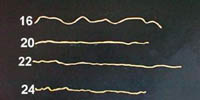
E
- Egg white powder
-
A powdered egg white portion of a chicken egg. The noodles will result strong and smooth. It also has the effect of not making too much soft the noodles when boiled.
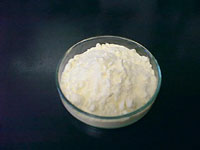
- Emulsification
- When preparing a dashi stock for soup, emulsification is what dissolves in hot water making it cloudy. There is also a way to make it whit the oil that floats over the surface with low heat and without making it cloudy. Scientifically indeed collagen is converted to gelatin serving as an "emulsifier" that acts as a link between water and oil and promoting emulsification.
- Fermented noodles (Jukuseimen)
- Noodles that have been let to rest for a long time at an appropriate temperature to bring out the best texture, taste, stretching, etc.
-
Related terms:
- Furizaru colander
- Used it to boil one portion of noodles. You can cook easily without having to divide noodles one portion by one when boiled.
- Ganko ramen
-
A generic term for Ichijo-ryu Ganko ramen restaurant and other shops derived from it. The master is Mr. Yasuyuki Ichijo, who has his main activity in Nishi-Waseda, Shinjuku ward, Tokyo.
There are no signboards and the store looks black from the outside. During business hours, a buffalo skull is just lighted as signal. The soup of this restaurant uses indeed beef and pork bones and is characterized by its unique salty taste.
- Genkotsu (Pork knuckle bone)
-
This name refers to the knee joint of the pig, because it resembles the shape of a person's fist called in Japanese genkotsu. After a long boiling is the essential ingredients to get a thick soup thanks to its good quality bone marrow
- Gluten
- When water is added to the flour and mixed, gluten is formed by proteins (glutenin and gliadin) in the flour. This will give the crunchy texture and the sticky consistence of ramen noodles.
- Glutamic acid
- It is a kind of umami component of amino acid. It is abundantly contained in kelp.
-
Related terms:
- Gyoza dumplings
- A food made by wrapping meat, fish and vegetables in a dough of wheat flour. Cooked by boiling, baking, steaming, frying, etc.
-
Related terms:
- Gyoza wrap (kawa)
- Skin made from wheat flour. It is mainly used for dumplings, but it is also popular as an ingredient for mini pizzas and winter hotpots.
-
Related terms:
- Hydrolysis rate
-
Percentage of moisture contained in noodles. Generally, the lower is the water content, the easier it is for noodles to absorb soup while the higher is the water content the softer the noodles will be.
The water content standard is about 35% but Sapporo Ramen has a high water content of 36 to 38%, while Asahikawa Ramen has a generally low water content of 28 to 31%.
I
- Iekei restaurants
- A group of famous ramen restaurants in the Yokohama area. These ramen restaurants originate from Yoshimuraya restaurants located near Shin Sugita area or are places that imitate its taste.
- Inosinic acid
- It is one of the umami components of amino acid. It is contained in large amounts in dried small sardines and tosabushi dried fish flakes from Shikoku region.
-
Related words:
- Instant ramen
-
The first of instant noodles to be marketed was the "Chicken Ramen" from Nisshin Foods Co., Ltd. in Osaka in August 1959.
The production volume in the first year of release was 13 million meals, but the following become70 million and 150 million meals two years later, showing a tremendous growth. After that, the temporary boom settled down but in September 1971 the company released the "cup noodles" and popularity became strong again. In 1975, the consumption of flour necessary to make dry noodles exceeded increased.
Japanese-born instant ramen has spread to countries around the world since its first arrival into the United States in 1970 and with the beginning of the 21st century 40.8 billion of instant ramen are currently consumed worldwide per year.
- Kaedama
- The word used to ask for another ramen bowl in Hakata, Fukuoka.
- Kansui
- An alkaline aqueous solution that gives the flavor, softness and elasticity of noodles.
- Keitaimen
- Chinese noodles using brine, which were introduced in the "Kageryoken Diary"of a monk living during the Muromachi period (1336-1573) . Currently, it is likely to be the oldest ramen in Japan
- Koshi
- If Ashi means stretch then Koshi means firmness. Koshi is affected by glutenin, a wheat protein that forms gluten.
-
Related words:
L
- Lard
- It is fat extracted from pork. Also known as “pure” lard. On the other hand, lard mixed with beef fat is called “adjusted” lard.
- Ladle
- A very important instrument to prepare and taste ramen soup.
- Mensuke
- The mascot of Nishiyama Seimen. His sister is Yakumi while younger brother is Menta. They often appear on social media. Check it out!
- Momiji chicken legs
-
Momiji means autumn maple leaves and indicates the chicken legs resembling them in shape. They are used to make a good and mild soup relatively quickly.
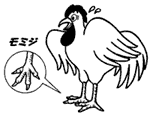
- Moyashi
- Bean sprouts. Popular toppings for Sapporo Miso Ramen.
- Nerimizu
-
Is the liquid made by mixing salt, kansui powder (lye water) and vitamin B2. It becomes the noodles mass when mixed with flour.
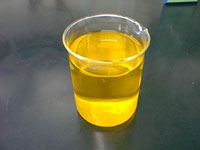
-
Related words:
- Niboshi
- A material often used to make ramen soup consisting in boiled and dried fry fish such as sardines. For soup sardines or anchovy are the mainly used but we sometimes also dried flying fish.
- Noodle craftsman certificate
- One of the certifications issued by the Minister of Health, Labor and Welfare of Japan. Test and certify the skills required to produce raw noodles.
- Noodle mass
-
Raw materials for ramen are mixed and then kneaded. The mass increases as the water increases.
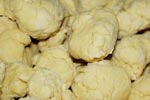
-
Related terms:
- Noodle strip
-
When the noodle mass is pressed between two rolls it transforms into a noodle strip.
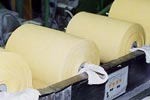
P
- Paitan soup
- It's a very rich soup, and it's white. Uses plenty of pork bone as the main ingredient and cooks for a long time. It becomes cloudy because the oil emulsifies and mixes well with the soup.
- Pork bone soy sauce
- A soup in which a large amount of soy sauce tare is added to a broth made from pork bones.
- Pork spine oil
- The best thing to put on a soup made with roasted pork with a low melting point, easy to dissolve in water and with a mellow texture. It gives a refined taste to the soup.
- Ramen bento
- It is a take-out ramen that can be eaten immediately after being heated in the microwave.
- Ramenist
- An Internet born term referring to those who like to eat ramen in different restaurants around Japan.
- RA-SALA
- Abbreviation for RAmen-SALAd that was born in Sapporo.
- Rayu
- Spicy oil using chili pepper.
- Renge
- A lotus petal-shaped spoon, suitable for drinking ramen soup while eating ramen.
- Shin-Yokohama Ramen Museum
-
It is a ramen museum that was built in the office district of a 5-minute walk distance from JR Shin-Yokohama Station in March 1994. It displays many valuable materials about ramen and sells original goods. Inside the museum, there is reproduced Tokyo's downtown area in 1959, and now there are nine restaurants where you can eat inside which are Ryu Shangai Honten (from Yamagata pref.), Rishiri Ramen Miraku (Hokkaido · Rishiri Island), Ryus Noodle bar (Brooklyn New York), Muku Zweite (Frankfurt, Germany), Komurasaki (Kumamoto), Sumire (Sapporo), Shina Soba-ya (Yokohama), second generation Genkotsu-ya (Tokyo), and Ryukyu Shinmen Tondou (Okinawa).

- Sanmamen
- For local people from Kanagawa Prefecture, the term "Sanma" means fresh ingredients in Chinese food. Ingredients such as Chinese cabbage and pork, as well as bean sprouts, are fried to leave a firm texture, then sprinkled with starch and put on soy sauce ramen. The perfect bowl is then the one which has fresh ingredients over a hot soup.
T
- Tama-age (circular colander)
- Men-age refers to the stainless steel net used to drain boiled noodles. This process determines the final quality of the ramen noodles. There are two types, vertical type used with the right hand and horizontal type used with the bowl hold in right hand while draining the noodles with the right hand.
- Tsukemen
- A type of ramen that puts cold noodles a part from soup (both cold and warm). There are many varieties, such as those with ingredients on top of the noodles and those with ingredients inside the dripping sauce. The taste can be various, such as sesame miso, Chinese style, or spicy.
- Vitamin B2
-
The yellow color is considered the most good one to make ramen noodles seem delicious. Originally, just by adding water-melt kansui powder (lye water) to wheat flour, the reaction with flavonoid pigments in wheat flour turned the noodles to yellow. However since its color was not so beautiful, noodles were made with fresh eggs. However given their conservation problems, now vitamin B2 is very popular to obtain a yellow color for noodles.
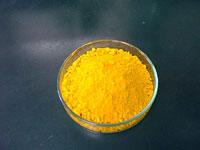
- Zundo (cylidrical pot)
- Zundo (cylindrical pots) are needed to make soup. Usually pots with 30 liters of capacity are used with constant temperature.
